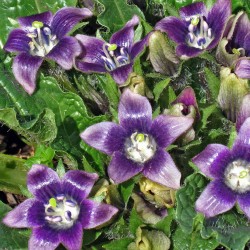Menu
-
MenuНазад
- Home
-
Категорії
-
-
Категорії
-
Насіння овочів
-
Сорти за країнами
- Сорти з Вірменії
- Сорти з БіГ
- Сорти з Хорватії
- Сорти з Франції
- Varieties from Germany
- Varieties from Greece
- Varieties from Hungary
- Сорти з Індії
- Varieties from Italy
- Сорти з Японії
- Сорти з Північної Македонії
- Varieties from Peru
- Varieties from Russia
- Varieties from Serbia
- Сорти зі Словенії
- Varieties from Spain
- Varieties from Thailand
- Сорти з Туреччини
- Varieties from USA
- Насіння томатів
- Насіння кукурудзи
- Сімейство гарбузових
- Родина бобових
- Насіння огірків
- Насіння болгарського перцю
- Сім'я морквяних
- Родина цибулевих
- Насіння салату
- Родина картопляних
- Сімейство капустяних
- Насіння редьки
- Родина бурякових
- Насіння кавуна
- Насіння дині
- Насіння цвітної капусти
- Родина соняшникових
-
Сорти за країнами
- Насіння фруктів
- Насіння перцю чилі
- Насіння лікарських трав
- Насіння рослин лазіння
- Дерева - Чагарник - Насіння
- Пальмове насіння
- Насіння декоративних трав
- Насіння тютюну
-
Насіння овочів
-
-
-
-
- НОВІ ПРОДУКТИ
- Доставка - Оплата
- Створити рахунок
- FAQ
Last Product Reviews
These peppers came all the way from eastern Europe and took a while at no f...
By
 Fitim Berani on 21/09/2023
Fitim Berani on 21/09/2023
Verified Purchase
Last customers
- Tanja, Beograd, Serbia
- Pete, Cleves, United States
- Stef, Waalwijk, Netherlands
- Sonia, Minervino di Lecce, Italy
- Adrian, Ingolstadt, Germany
- CORINNE, NOTRE DAME DE LONDRES, France
- Dušan, KRAVANY NAD DUNAJOM, Slovakia
- Arno, Ehrenkirchen, Germany
- Costas, LARNACA , Cyprus
- Fulvio francesco, Santa Domenica Talao, Italy
- william, Dun, France
- Aymeric , Saint tricat, France
- Ricard, Sant Celoni, Spain
- Maureen, Enniscorthy Co Wexford , Ireland
- Paul, St. Vigil in Enneberg (BZ), Italy
- Ricardo jorge , Viseu , Portugal
- Radosav, Kragujevac, Serbia
- Sylvie, Neyruz, Switzerland
- Julien, Scionzier, France
- Zoran, Vinca, Serbia
- Josef, Hochdorf-Assenheim, Germany
- Davide, London, United Kingdom
- Kimberly, Victoria, Gozo, Malta
- Saša , Beograd, Serbia
- Ewa, Galway, Ireland
- Ioannis , Kato Achaia, Greece
- Samuele, Milano, Italy
- Dubravka, Niš , Serbia
- Theodoros, Grevena, Greece
- goderis, bredene, Belgium
Знайдено товарів: 170.
Показати 145-156 з 170 товарів
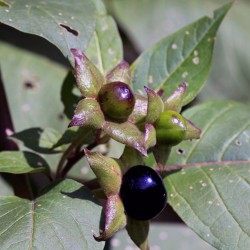
Насіння Беладо́на лікарська...
Ціна
3,75 €
SKU: MHS 58
Seeds Gallery Com,
5/
5
<!DOCTYPE html>
<html>
<head>
<meta http-equiv="Content-Type" content="text/html; charset=UTF-8" />
</head>
<body>
<h2><strong>Насіння Беладо́на лікарська (Atropa belladonna)</strong></h2>
<h2><span style="color: #ff0000;"><strong>Ціна за упаковку з 5 насінин.</strong></span></h2>
<p>Atropa Belladonna, або <span style="color: #000000;"><strong>вишня диявола</strong></span>, використовується більше двох тисячоліть як лікарський засіб, косметика, отрута та відьма. Беладонна - багаторічна, насіннєва, гілляста рослина, яка виростає до 1,5 метрів у висоту, з листям завдовжки 12-13 см і фіолетовим стеблом. Взимку гине, а навесні знову сходить.</p>
<p>Протягом століть відьми використовували його у формулах, венеціанські жінки загалом, і особливо "нічні дами" для розширення очей, і в даний час він використовується як засіб проти хвороби руху, СРК та інших кишкових розладів. Беладонна також використовувалася для отруєння цілих армій на війні. Кажуть, що сатана особисто піклувався про цю рослину та його маленькі "диявольські вишні".</p>
<p>Містить психотропні / токсичні / рятувальні алкалоїди, включаючи атропін. Ця рослина є ліками, галюциногеном і отрутою. Смерть може (і трапляється) від погано обізнаних людей, наприклад, вживаючи в пироги занадто багато стиглих ягід, тому не робіть цього. Ягоди смачні (я їх їв сам, і вони досить смачні). Це рослина, яка є основним інгредієнтом секретного напою-формули "Летюча формула", який відьми використовували століттями.</p>
<p>Ця трава дійсно може викликати у вас відчуття, ніби ваша душа подорожує, але споживання занадто багато може призвести до летального результату. Також його можна використовувати як протиотруту при отруєнні газами.</p>
<h3><strong>Культура</strong></h3>
<p>Його можна розмножувати посівом насіння або живцями, хоча використання насіння є більш рекомендованим. За кілька годин до посіву насіння слід помістити в гарячу воду. Їм потрібен час, щоб прорости, і їм потрібна висока вологість і тепло, і, зберігаючи всі необхідні умови, схожість не велика. Рослини оцінять компостний субстрат з гноєм та вологим, тінистим середовищем. Нітрати та аміачні солі - найкраще добриво для подвоєння кількості алкалоїдів.</p>
<h3><strong>WIKIPEDIA:</strong></h3>
<p><b>Беладо́на звича́йна</b>,<span> </span><b>беладонна лікарська</b>,<span> </span><b>белладонна звичайна</b><sup id="cite_ref-Кобів_1-0" class="reference">[1]</sup><span> </span>(<i>Atropa belladonna</i>) —<span> </span>отруйна<span> </span>багаторічна<span> </span>трав'яниста рослина<span> </span>родини<span> </span>пасльонових<span> </span>(Solanaceae).</p>
<p>В Україні трапляється в<span> </span>Криму,<span> </span>Карпатах, західному<span> </span>Лісостепу,<span> </span>Розточчі,<span> </span>Опіллі; отруйна (містить ряд<span> </span>алкалоїдів<span> </span>групи<span> </span>атропіну). При отруєнні беладонною стан збудження<span> </span>нервової системи<span> </span>швидко змінюється її пригніченням; бувають випадки<span> </span>смерті. Характерна риса отруєння — розширення<span> </span>зіниць. Лікування: промивання<span> </span>шлунково-кишкового тракту, у тяжких випадках — серцеві і заспокійливі засоби. Настойки і екстракти беладонни використовують у<span> </span>медицині<span> </span>як болезаспокійливі і протиспазматичні засоби при<span> </span>шлунково-кишкових,<span> </span>нервових<span> </span>та інших захворюваннях.</p>
<p>Беладонна культивується в Україні як<span> </span>лікарська рослина.</p>
<h2><span class="mw-headline" id="Ботанічна_характеристика">Ботанічна характеристика</span></h2>
<p>Багаторічна<span> </span>трав'яниста рослина<span> </span>заввишки до 1,5 м.<span> </span>Стебло<span> </span>розгалужене,<span> </span>листки<span> </span>яйцеподібно загострені;<span> </span>квітки<span> </span>брудночервонуваті, поодинокі, пониклі;<span> </span>плід — чорна блискуча<span> </span>ягода.</p>
<h2><span id=".D0.9F.D0.BE.D1.88.D0.B8.D1.80.D0.B5.D0.BD.D0.BD.D1.8F"></span><span class="mw-headline" id="Поширення">Поширення</span></h2>
<p>Росте в листяних<span> </span>лісах, між<span> </span>чагарниками, на молодих лісосіках переважно на відкритих місцях. Природні зарості можна використати як насіннєву базу для селекційної роботи.</p>
<h2><span id=".D0.A4.D0.B0.D1.80.D0.BC.D0.B0.D0.BA.D0.BE.D0.BB.D0.BE.D0.B3.D1.96.D1.87.D0.BD.D1.96_.D0.B2.D0.BB.D0.B0.D1.81.D1.82.D0.B8.D0.B2.D0.BE.D1.81.D1.82.D1.96"></span><span class="mw-headline" id="Фармакологічні_властивості">Фармакологічні властивості</span></h2>
<p>З лікувальною метою використовують листки (лат.<span> </span><i lang="la">Folia belladonnae</i>),<span> </span>корені<span> </span>(Radix belladonnae) і траву (Herba belladonnae). Листки містять в собі<span> </span>алкалоїди, переважно<span> </span>гіосциамін, а також<span> </span>скополамін<span> </span>(гіосцин),<span> </span>глюкозид<span> </span>метилескулін,<span> </span>аспарагін,<span> </span>смолисті речовини. Корінь містить до 1,5 % алкалоїду, в основному гіосциаміну, глюкозид метилескулін і до 12 %<span> </span>дубильних речовин. З листя беладони виготовляють<span> </span>фармацевтичні препарати —<span> </span>екстракти<span> </span>і<span> </span>настойки, новогаленові препарати, які вживають як<span> </span>болезаспокійливий<span> </span>і<span> </span>протиспазматичний засоби<span> </span>при<span> </span>бронхіальній астмі,<span> </span>шлунковокишкових захворюваннях, а також при отруєнні<span> </span>морфієм.<span> </span>Гіосциамін<span> </span>розширює<span> </span>зіниці.</p>
<h2><span id=".D0.9C.D0.B5.D0.B4.D0.B8.D1.87.D0.BD.D0.B5_.D0.B7.D0.B0.D1.81.D1.82.D0.BE.D1.81.D1.83.D0.B2.D0.B0.D0.BD.D0.BD.D1.8F"></span><span class="mw-headline" id="Медичне_застосування">Медичне застосування</span></h2>
<p>Міцний<span> </span>відвар<span> </span>коренів призначають при<span> </span>паркінсонізмі. З коренів і<span> </span>листків<span> </span>одержують<span> </span>атропін.</p>
<h2><span id=".D0.97.D0.B0.D0.B3.D0.BE.D1.82.D1.96.D0.B2.D0.BB.D1.8F"></span><span class="mw-headline" id="Заготівля">Заготівля</span></h2>
<p>Листки збирають в період<span> </span>цвітіння, в<span> </span>червні —<span> </span>липні, 3—4 рази, в міру їх відростання. Общипують біля основи листкової пластинки. Сушать негайно в тіні.</p>
<p>Коріння збирають восени (вересень — жовтень) з рослин другого року. Заготовляють тільки м'ясисті, соковиті, бічні корені, видаляючи дерев'янисту основу головного кореня. Сушать в затінених, добре провітрюваних місцях.</p>
<p>Вся<span> </span>рослина отруйна, що слід враховувати під час її збирання і сушіння: не торкатися носа, очей, губ, а після закінчення роботи мити руки.</p>
</body>
</html>
MHS 58 (5 S)


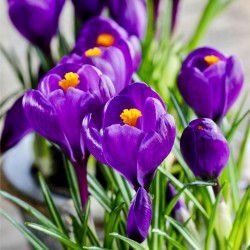
Purple Crocus bulbs
Ціна
3,50 €
SKU: F 81 P
Seeds Gallery Com,
5/
5
<!DOCTYPE html>
<html>
<head>
<meta http-equiv="Content-Type" content="text/html; charset=UTF-8" />
</head>
<body>
<h2><strong>Purple Crocus bulbs</strong></h2>
<h2><span style="color: #ff0000;"><strong>The price is for package of 3 bulbs.</strong></span></h2>
<p><span style="font-size: 11pt; color: #000000; font-family: georgia, palatino;"><i><b><strong><span style="font-size: 12pt;">This variety is famous for its delightful fragrance. There's nothing like closing your eyes and breathing in the sweet scent of Spring! </span></strong></b></i></span></p>
<p><span style="font-size: 11pt; color: #000000; font-family: georgia, palatino;"><i><b>Crocus</b></i> (English plural: crocuses or croci) is a genus of flowering plants in the iris family comprising 90 species of perennials growing from corms. Many are cultivated for their flowers appearing in autumn, winter, or spring. The spice saffron is obtained from the stigmas of <i>Crocus sativus</i>, an autumn-blooming species. Crocuses are native to woodland, scrub, and meadows from sea level to alpine tundra in central and southern Europe, in particular Krokos, Greece<sup id="cite_ref-2" class="reference"></sup>, on the islands of the Aegean, North Africa and the Middle East, and across Central Asia to Xinjiang Province in western China.</span></p>
<p><span style="font-size: 12pt; font-family: georgia, palatino; color: #000000;">The cup-shaped, solitary, salverform flower tapers off into a narrow tube. Their colors vary enormously, although lilac, mauve, yellow, and white are predominant. The grass-like, ensiform leaf<sup id="cite_ref-10" class="reference"></sup> shows generally a white central stripe along the leaf axis. The leaf margin is entire.</span></p>
<p><span style="font-size: 12pt; font-family: georgia, palatino; color: #000000;">A crocus has three stamens, while a similar-looking toxic plant, <i>colchicum</i>, sometimes popularly referred to as "autumn crocus", has six stamens. In addition, crocus have one style, while <i>colchicum</i> have three.</span></p>
<p><span style="font-size: 12pt; font-family: georgia, palatino; color: #000000;">About 30 of the species are cultivated, including <i>Crocus sativus</i> for saffron production. The varieties cultivated for decoration mainly represent five species: <i>C. vernus</i>, <i>C. chrysanthus</i>, <i>C. flavus</i>, <i>C. sieberi</i>, and <i>C. tommasinianus</i>. Among the first flowers to bloom in spring, crocuses are popular with gardeners. Their flowering time varies from the late winter <i>C. tommasinianus</i> to the later large hybridized and selected Giant "Dutch crocuses" (<i>C. vernus</i>). Crocus flowers and leaves are protected from frost by a waxy cuticle; in areas where snow and frost occasionally occur in the early spring, it is not uncommon to see early flowering crocuses blooming through a light late snowfall.</span></p>
<h2><span style="color: #ff0000; font-size: 13pt; font-family: georgia, palatino;"><a href="https://www.seeds-gallery.shop/en/home/saffron-bulbs-saffron-crocus.html" target="_blank" title="Saffron Bulbs can be purchased here" style="color: #ff0000;" rel="noreferrer noopener"><strong>Saffron Bulbs can be purchased here</strong></a></span></h2>
</body>
</html>
F 81 P


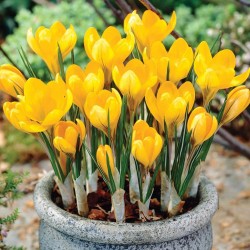
Yellow Crocus bulbs
Ціна
3,50 €
SKU: F 81 Y
Seeds Gallery Com,
5/
5
<!DOCTYPE html>
<html>
<head>
<meta http-equiv="Content-Type" content="text/html; charset=UTF-8" />
</head>
<body>
<h2><strong>Yellow Crocus bulbs</strong></h2>
<h2><span style="color: #ff0000;"><strong>The price is for package of 3 bulbs.</strong></span></h2>
<p><span style="font-size: 11pt; color: #000000; font-family: georgia, palatino;"><i><b><strong><span style="font-size: 12pt;">This variety is famous for its delightful fragrance. There's nothing like closing your eyes and breathing in the sweet scent of Spring! </span></strong></b></i></span></p>
<p><span style="font-size: 11pt; color: #000000; font-family: georgia, palatino;"><i><b>Crocus</b></i> (English plural: crocuses or croci) is a genus of flowering plants in the iris family comprising 90 species of perennials growing from corms. Many are cultivated for their flowers appearing in autumn, winter, or spring. The spice saffron is obtained from the stigmas of <i>Crocus sativus</i>, an autumn-blooming species. Crocuses are native to woodland, scrub, and meadows from sea level to alpine tundra in central and southern Europe, in particular Krokos, Greece<sup id="cite_ref-2" class="reference"></sup>, on the islands of the Aegean, North Africa and the Middle East, and across Central Asia to Xinjiang Province in western China.</span></p>
<p><span style="font-size: 12pt; font-family: georgia, palatino; color: #000000;">The cup-shaped, solitary, salverform flower tapers off into a narrow tube. Their colors vary enormously, although lilac, mauve, yellow, and white are predominant. The grass-like, ensiform leaf<sup id="cite_ref-10" class="reference"></sup> shows generally a white central stripe along the leaf axis. The leaf margin is entire.</span></p>
<p><span style="font-size: 12pt; font-family: georgia, palatino; color: #000000;">A crocus has three stamens, while a similar-looking toxic plant, <i>colchicum</i>, sometimes popularly referred to as "autumn crocus", has six stamens. In addition, crocus have one style, while <i>colchicum</i> have three.</span></p>
<p><span style="font-size: 12pt; font-family: georgia, palatino; color: #000000;">About 30 of the species are cultivated, including <i>Crocus sativus</i> for saffron production. The varieties cultivated for decoration mainly represent five species: <i>C. vernus</i>, <i>C. chrysanthus</i>, <i>C. flavus</i>, <i>C. sieberi</i>, and <i>C. tommasinianus</i>. Among the first flowers to bloom in spring, crocuses are popular with gardeners. Their flowering time varies from the late winter <i>C. tommasinianus</i> to the later large hybridized and selected Giant "Dutch crocuses" (<i>C. vernus</i>). Crocus flowers and leaves are protected from frost by a waxy cuticle; in areas where snow and frost occasionally occur in the early spring, it is not uncommon to see early flowering crocuses blooming through a light late snowfall.</span></p>
<h2><span style="color: #ff0000; font-size: 13pt; font-family: georgia, palatino;"><a href="https://www.seeds-gallery.shop/en/home/saffron-bulbs-saffron-crocus.html" target="_blank" title="Saffron Bulbs can be purchased here" style="color: #ff0000;" rel="noreferrer noopener"><strong>Saffron Bulbs can be purchased here</strong></a></span></h2>
</body>
</html>
F 81 Y


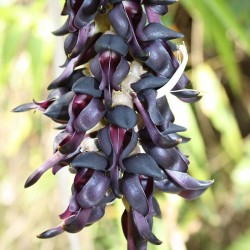
Насіння лози чорного...
Ціна
12,50 €
SKU: T 74 B
Seeds Gallery Com,
5/
5
<!DOCTYPE html>
<html>
<head>
<meta http-equiv="Content-Type" content="text/html; charset=UTF-8" />
</head>
<body>
<h2><strong>Насіння лози чорного нефриту (Mucuna nigricans)</strong></h2>
<h2><span style="color: #ff0000;"><strong>Cena za opakowanie 1 nasion.</strong></span></h2>
<p>To piękna kwitnąca winorośl. Ciemnofioletowe kwiaty wydają się być ściśnięte razem w gronach przypominających winogrona, o długości do 30 cm i średnicy 15 cm. Bardzo energiczne pnącze drzewiaste - w cieplejsze dni winorośl osiąga 60 cm lub więcej tygodniowo. Pędy mogą osiągać do 18 m długości</p>
</body>
</html>
T 74 B

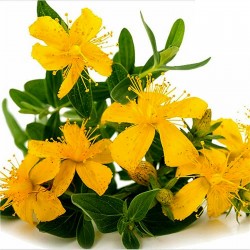
Звіробій звичайний Насіння...
Ціна
1,95 €
SKU: MHS 45
Seeds Gallery Com,
5/
5
<h2><strong>Звіробій звичайний Насіння (Hypericum perforatum)</strong></h2>
<h2><span style="color: #ff0000;" class=""><strong>Ціна за упаковку 1000 (0.1g) насінин.</strong></span></h2>
<p><b>Звіробій звичайний</b><span> </span>(<i>Hypericum perforatum</i><span> </span>L.), місцеві назви: стокровиця, калмицький чай, зілля свєтоянське, заяча крівця тощо —<span> </span>багаторічна<span> </span>трав'яниста рослина<span> </span>родини<span> </span>звіробійних.</p>
<h2><span class="mw-headline" id="Біологічний_опис">Біологічний опис</span></h2>
<p>Стебло<span> </span>пряме, голе, вгорі гіллясте, 30-60 см заввишки.<span> </span>Міжвузля<span> </span>округлі або з двома гранями, щільні.<span> </span>Листки<span> </span>супротивні, сидячі, овальні, видовжено-яйцеподібні або видовжені, тупуваті, цілокраї, з численними<span> </span>залозками.<span> </span>Квітки<span> </span>правильні, зібрані в щитоподібну волоть або нещільну китицю.<span> </span>Чашечка<span> </span>з п'яти зрослих при основі ланцетних, загострених, гладеньких по краю чашолистків.<span> </span>Віночок<span> </span>п'ятичленний, жовтий, пелюстки з численними чорно-бурими або фіолетовими крапками.<span> </span>Тичинок<span> </span>багато,<span> </span>маточка<span> </span>одна з верхньою<span> </span>зав'яззю<span> </span>і трьома-п'ятьма стовпчиками.<span> </span>Плід — багатонасінна тригранна коробочка.</p>
<h2><span id=".D0.95.D0.BA.D0.BE.D0.BB.D0.BE.D0.B3.D1.96.D1.8F"></span><span class="mw-headline" id="Екологія">Екологія</span></h2>
<p>Росте у мішаних лісах, на галявинах, лісосіках, серед чагарників. Тіньовитривала рослина. Цвіте у червні-серпні.</p>
<h2><span id=".D0.9F.D0.BE.D1.88.D0.B8.D1.80.D0.B5.D0.BD.D0.BD.D1.8F"></span><span class="mw-headline" id="Поширення">Поширення</span></h2>
<p>Поширений по всій території<span> </span>України. Промислова заготівля можлива у<span> </span>Волинській,<span> </span>Житомирській,<span> </span>Київській,<span> </span>Чернігівській,<span> </span>Львівській,<span> </span>Тернопільській,<span> </span>Хмельницькій,<span> </span>Сумській,<span> </span>Полтавській,<span> </span>Кіровоградській,<span> </span>Черкаській,<span> </span>Івано-Франківській,<span> </span>Чернівецькій,<span> </span>Закарпатській<span> </span>областях. Запаси сировини значні.</p>
<p>Лікарська, фітонцидна, ефіроолійна, танідоносна, харчова, фарбувальна,<span> </span>медоносна,<span> </span>отруйна<span> </span>рослина.</p>
<p>У науковій<span> </span>медицині<span> </span>використовують квітучі верхівки пагонів — Herba Нурегісі як в'яжучий, протизапальний і тонізуючий засіб при<span> </span>кровохарканні,<span> </span>кашлі,<span> </span>проносах,<span> </span>колітах,<span> </span>хворобах<span> </span>печінки, для укріплення<span> </span>ясен. Лікарські властивості звіробою пов'язані з його досить складним<span> </span>хімічним складом.</p>
<p>Трава<span> </span>звіробою містить біля 4% флавоноїдів (гіперозид,<span> </span>кверцетин,<span> </span>псевдогіперецин,<span> </span>гіперецин, складні<span> </span>ефіри<span> </span>ізовалеріанової кислоти<span> </span>(заспокійлива дія),<span> </span>дубильні речовини<span> </span>(катехіни), бактеріостатичні смолисті речовини,<span> </span>цериловий спирт,<span> </span>нікотинову кислоту.<span> </span><sup id="cite_ref-1" class="reference">[1]</sup></p>
<p>Із звіробою звичайного виробляють<span> </span>антибактеріальні препарати<span> </span>іманін і новоіманін, якими лікують<span> </span>гнійні рани, тяжкі<span> </span>опіки, гострі<span> </span>катари<span> </span>дихальних шляхів. Новоіманін використовують для боротьби з<span> </span>бактеріозами<span> </span>овочевих<span> </span>рослин і проти<span> </span>вірусної мозаїки<span> </span>тютюну. Звіробоєм лікують<span> </span>стоматити,<span> </span>гайморити,<span> </span>фарингіти,<span> </span>молочницю<span> </span>у дітей.</p>
<p>Важливими комопнентами звіробою звичайного є антраценпохідні сполуки -<span> </span>гіперицини<span> </span>та похідне флороглюцинолу -<span> </span>гіперфорин. Ці компоненти зумовлюють антидепресивну дію звіробою звичайного. На ринку України і світу є низка препаратів з такою дією, основою котрих є звіробій (Депривіт, Седатон та інші).</p>
<p>У<span> </span>народній медицині<span> </span>звіробій дуже популярний<span> </span>лікувальний засіб, який застосовується при багатьох хворобах:<span> </span>проносах,<span> </span>шлунково-кишкових захворюваннях, хворобах дихальних шляхів, як тонізуючий засіб при<span> </span>серцево-судинних захворюваннях, як кровоспинний — при маткових кровотечах, хворобах печінки,<span> </span>нирок<span> </span>і як<span> </span>глистогінний засіб, при<span> </span>невралгіях,<span> </span>істерії,<span> </span>безсонні,<span> </span>епілепсії,<span> </span>паралічах.</p>
<p>Відваром<span> </span>трави миють дітей при<span> </span>діатезах,<span> </span>туберкульозі<span> </span>шкіри, при<span> </span>висипах,<span> </span>наривах, а при хворобах<span> </span>молочних залоз<span> </span>прикладають<span> </span>компреси. Корені рослини застосовують при<span> </span>шигельозі<span> </span>та<span> </span>туберкульозі<span> </span>кісток.</p>
<p>У народі існує популярний<span> </span>рецепт<span> </span>звіробійної олії, яку радять готувати таким чином: узяти одну частину свіжих квіток звіробою і залити 10 частинами лляної чи соняшникової олії. Настоювати протягом 2 тижнів поки олія не почервоніє. Можна готувати за іншим рецептом (тоді настій буде концентрованішим): 1 частина звіробою — 2 частини олії. Тут добре використати олію маслинову, рафіновану кукурудзяну чи соняшникову, настоювати 3 тижні.</p>
<p>Звіробійну олію використовують для лікування ран, виразок, наривів, розпушених ясен, уражень слизової оболонки рота. Усередину вживають для зміцнення серцевого м'яза<span> </span>[1].</p>
<p>Деякі травознаї, як<span> </span>Наталя Земна, не рекомендують вживати звіробій протягом тривалого часу, особливо чоловікам (не більше 7 днів на рік).</p>
<p>У<span> </span>гомеопатії<span> </span>використовують<span> </span>есенцію<span> </span>з свіжої квітучої рослини.</p>
<p>У<span> </span>ветеринарії<span> </span>для лікування ран застосовують емульсію з настою трави, виготовлену на<span> </span>вазеліновій<span> </span>олії.<span> </span>Фітонцидні властивості<span> </span>звіробою зумовлені наявністю в ньому<span> </span>ефірних олій<span> </span>(0,09-0,114 %), до складу яких входять<span> </span>пінен,<span> </span>мірцен,<span> </span>цінеол. Олію з звіробою використовують у<span> </span>парфумерії, для<span> </span>лікування<span> </span>ран і опіків,<span> </span>виразок шлунка<span> </span>та<span> </span>дванадцятипалої кишки.</p>
<p>В усіх частинах рослини є<span> </span>таніди<span> </span>(до 7,5 %), тому її застосовують для дублення шкур, надаючи їм еластичності, щільності та приємного забарвлення.</p>
<p>У харчовій промисловості звіробій використовують для приготування гірких горілок і настоїв, а листки — як сурогат чаю. Квітки містять барвник гіперицин, з різними протравами вони дають жовту, зелену, червону, рожеву фарби,, придатні для фарбування шерсті. Звіробій звичайний — добрий пилконос.</p>
<p>У траві звіробою знайдені сапоніни. При з'їданні великої кількості його вівці, коні й велика рогата худоба отруюються. Цікаво відзначити, що отруюються, як правило, тварини з білою шерстю. Звіробій викликає розвиток дерматитів у білошерстих тварин, сверблячку, параліч аборти. Інші види звіробою в науковій медицині не використовуються і домішки їх до сировини з трави звіробою звичайного небажані.</p>
<h2><span id=".D0.97.D0.B1.D0.B8.D1.80.D0.B0.D0.BD.D0.BD.D1.8F.2C_.D0.BF.D0.B5.D1.80.D0.B5.D1.80.D0.BE.D0.B1.D0.BA.D0.B0_.D1.82.D0.B0_.D0.B7.D0.B1.D0.B5.D1.80.D1.96.D0.B3.D0.B0.D0.BD.D0.BD.D1.8F"></span><span class="mw-headline" id="Збирання,_переробка_та_зберігання">Збирання, переробка та зберігання</span></h2>
<p>Збирають верхівки рослин під час цвітіння, зрізуючи їх ножами або серпами (довжина пагонів 25-30 см) без грубих безлистих частин. Сировину сушать на горищах, під залізним дахом або в сушарках при температурі до 40°, розтираючи тонким шаром на папері, тканині або решетах і часто помішуючи. Висушену траву обмолочують і відділяють на решетах стебла. Суху сировину пакують у тюки по 50 або 100 кг. Зберігають у сухих, добре провітрюваних приміщеннях. Строк зберігання три роки.</p><script src="//cdn.public.n1ed.com/G3OMDFLT/widgets.js"></script>
MHS 45 (1000 S)


Это растение устойчиво к зиме и морозу. Смотрите больше в описании.

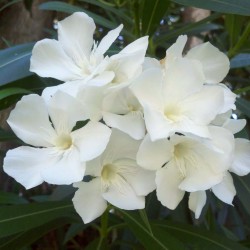
Насіння білого Олеандр...
Ціна
1,95 €
SKU: T 62 W
Seeds Gallery Com,
5/
5
<!DOCTYPE html>
<html>
<head>
<meta http-equiv="Content-Type" content="text/html; charset=UTF-8" />
</head>
<body>
<h2><strong>Насіння білого Олеандр звичайний (Nerium oleander)</strong></h2>
<h2><span style="color: #ff0000;"><strong>Ціна за упаковку з 10 насінин.</strong></span></h2>
<p><b>Олеа́ндр звича́йний</b><span> (</span><i>Nerium oleander</i><span>) — отруйна </span>багаторічна рослина<span> родини </span>барвінкових<span>. Поширена </span>декоративна культура<span>, що також використовується як </span>лікарська рослина<span>.</span></p>
<p>Українська назва<span> </span><i>олеандр</i><span> </span>походить із західноєвропейських мов (фр.<span> </span><i lang="fr">oléandre</i>,<span> </span>англ.<span> </span><i lang="en">oleander</i>,<span> </span>нім.<span> </span><i lang="de">Oleander</i>,<span> </span>італ.<span> </span><i lang="it">oleandro</i>), де сходить до сер.-лат.<span> </span><i lang="la">oleander</i>, що являє собою видозміну раніших форм<span> </span><i>rodandrum, rhododendron</i><span> </span>(«рожеве дерево»,<span> </span>«рододендрон»)<sup id="cite_ref-1" class="reference">[1]</sup>.</p>
<p>Японська назва (яп.<span> </span><span lang="ja">夾竹桃, キョウチクトウ</span>,<span> </span><i>кьотікуто</i><span> </span>означає «персик з листям бамбука». Вона походить від того, що олеандр має листя подібне до листя<span> </span>бамбука, а квіти подібні до квітів<span> </span>персика) — вид вічнозелених низькорослих кущів, єдиний представник роду<span> </span>олеандр<span> </span>(<i>Nerium</i>).</p>
<p>Батьківщиною виду є<span> </span>Індія. Він поширений також у країнах<span> </span>Східної Азії. До Японії потрапив через Китай у середині 18 століття.</p>
<p>Сік листків олеандра є отруйним, що характерно для рослин цього роду, а також багатьох<span> </span>субтропічних<span> </span>і<span> </span>тропічних<span> </span>рослин.</p>
<p>Олеандр звичайний є символом-квіткою<span> </span>японського<span> </span>міста<span> </span>Хіросіма.</p>
<h2><span id=".D0.97.D0.BE.D0.B2.D0.BD.D1.96.D1.88.D0.BD.D1.96.D0.B9_.D0.B2.D0.B8.D0.B3.D0.BB.D1.8F.D0.B4"></span><span class="mw-headline" id="Зовнішній_вигляд">Зовнішній вигляд</span></h2>
<p>Кущ або невелике (3—4 м заввишки) дерево родини барвінкових. Стебла розгалужені, з гладенькою світло-сірою корою. Листки вічнозелені, шкірясті, цілокраї, зісподу опушені. Квітки правильні, двостатеві, на довгих повстистоопушених<span> </span>квітконіжках, зібрані у верхівкові півзонтики; віночок рожевий, рідше білий, зросло-пелюстковий, з п'ятилопатевим відгином і зубчастими виростами в зіві. Плід складається з двох листянок. Цвіте з червня по серпень.</p>
<h2><span id=".D0.9F.D0.BE.D1.88.D0.B8.D1.80.D0.B5.D0.BD.D0.BD.D1.8F"></span><span class="mw-headline" id="Поширення">Поширення</span></h2>
<p>Олеандр звичайний походить з Середземномор'я. У Південному Криму його широко розводять у відкритому ґрунті як декоративну рослину. Вирощують його і як кімнатну квіткову рослину.</p>
<h2><span id=".D0.97.D0.B0.D0.B3.D0.BE.D1.82.D1.96.D0.B2.D0.BB.D1.8F_.D1.96_.D0.B7.D0.B1.D0.B5.D1.80.D1.96.D0.B3.D0.B0.D0.BD.D0.BD.D1.8F"></span><span class="mw-headline" id="Заготівля_і_зберігання">Заготівля і зберігання</span></h2>
<p>Для виготовлення ліків використовують цілком розвинуте листя олеандра (Folia Nerii oleandri; Folia Nerii, Folia Oleandri), яке заготовляють у жовтні — листопаді або у квітні (до початку активного росту пагонів). Перевагу віддають весняному строку заготівлі. Листя обшморгують руками (в захисних рукавицях!) з обрізаних при декоративному формуванні кущів пагонів і швидко сушать під укриттям на вільному повітрі або в теплих кімнатах, розстеливши тонким (2—3 см завтовшки) шаром на тканині чи папері. Штучне сушіння проводять при температурі 50°. Сушіння припиняють, коли черешки стають ламкими. Зберігають олеандр окремо від іншої сировини, дотримуючись правил зберігання отруйних рослин. Для місцевого лікування частіше використовують свіжі або сушені квітки з листям (вершки квітучих гілок).</p>
<h2><span id=".D0.A5.D1.96.D0.BC.D1.96.D1.87.D0.BD.D0.B8.D0.B9_.D1.81.D0.BA.D0.BB.D0.B0.D0.B4"></span><span class="mw-headline" id="Хімічний_склад">Хімічний склад</span></h2>
<p>Листя олеандра містить карденоліди:<span> </span>олеандрин<sup class="noprint"><span title="Oleandrin — версія статті «олеандрин» англійською мовою">[en]</span></sup><span> </span>(0,08—0,15 %), дигіталін, дезаце-тилолеандрин і одинерин, діуретично діючу субстанцію нериїн,<span> </span>флавоноїди<span> </span>(рутин, кемпферол-3-рамноглюкозид і ін.), сапонін карабін, урсолову кислоту.</p>
<h2><span id=".D0.A4.D0.B0.D1.80.D0.BC.D0.B0.D0.BA.D0.BE.D0.BB.D0.BE.D0.B3.D1.96.D1.87.D0.BD.D1.96_.D0.B2.D0.BB.D0.B0.D1.81.D1.82.D0.B8.D0.B2.D0.BE.D1.81.D1.82.D1.96_.D1.96_.D0.B2.D0.B8.D0.BA.D0.BE.D1.80.D0.B8.D1.81.D1.82.D0.B0.D0.BD.D0.BD.D1.8F"></span><span class="mw-headline" id="Фармакологічні_властивості_і_використання">Фармакологічні властивості і використання</span></h2>
<p>Олеандр звичайний ефективний кардіотонічний засіб, за своєю дією схожий на<span> </span>серцеві засоби<span> </span>наперстянки. У процесі експериментальних досліджень встановлено, що препарати олеандра покращують серцеву діяльність, сповільнюють ритм серця, підвищують діурез, розширюють вінцеві судини, знижують артеріальний тиск. На відміну від глікозидів<span> </span>наперстянки, глікозиди олеандра діють швидше і м'якше, швидше виводяться з організму. Крім кардіотонічної дії, водні екстракти олеандра виявляють противірусну активність і мають цитотоксичні властивості. Олеандр звичайний призначають у випадку тахіаритмії, при легких формах серцевої недостатності та при стенокардії. У народній медицині настій листя олеандра п'ють при нервовому виснаженні, головних болях, епілепсії, апоплексії, безсонні, при м'язових спазмах, у разі діареї та як вітрогінний засіб. Як зовнішній засіб настій листя використовують для примочок і компресів при шкірних хворобах (мокнуча екзема, лишай тощо), для полоскання при зубному болю.</p>
</body>
</html>
T 62 W


Это растение устойчиво к зиме и морозу. Смотрите больше в описании.

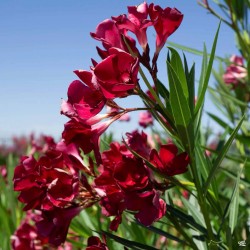
Насіння Червоний Олеандр...
Ціна
1,95 €
SKU: T 62 R
Seeds Gallery Com,
5/
5
<!DOCTYPE html>
<html>
<head>
<meta http-equiv="Content-Type" content="text/html; charset=UTF-8" />
</head>
<body>
<h2><strong>Насіння Червоний Олеандр звичайний (Nerium oleander)</strong></h2>
<h2><span style="color: #ff0000;"><strong>Ціна за упаковку з 10 насінин.</strong></span></h2>
<p><b>Олеа́ндр звича́йний</b><span> (</span><i>Nerium oleander</i><span>) — отруйна </span>багаторічна рослина<span> родини </span>барвінкових<span>. Поширена </span>декоративна культура<span>, що також використовується як </span>лікарська рослина<span>.</span></p>
<p>Українська назва<span> </span><i>олеандр</i><span> </span>походить із західноєвропейських мов (фр.<span> </span><i lang="fr">oléandre</i>,<span> </span>англ.<span> </span><i lang="en">oleander</i>,<span> </span>нім.<span> </span><i lang="de">Oleander</i>,<span> </span>італ.<span> </span><i lang="it">oleandro</i>), де сходить до сер.-лат.<span> </span><i lang="la">oleander</i>, що являє собою видозміну раніших форм<span> </span><i>rodandrum, rhododendron</i><span> </span>(«рожеве дерево»,<span> </span>«рододендрон»)<sup id="cite_ref-1" class="reference">[1]</sup>.</p>
<p>Японська назва (яп.<span> </span><span lang="ja">夾竹桃, キョウチクトウ</span>,<span> </span><i>кьотікуто</i><span> </span>означає «персик з листям бамбука». Вона походить від того, що олеандр має листя подібне до листя<span> </span>бамбука, а квіти подібні до квітів<span> </span>персика) — вид вічнозелених низькорослих кущів, єдиний представник роду<span> </span>олеандр<span> </span>(<i>Nerium</i>).</p>
<p>Батьківщиною виду є<span> </span>Індія. Він поширений також у країнах<span> </span>Східної Азії. До Японії потрапив через Китай у середині 18 століття.</p>
<p>Сік листків олеандра є отруйним, що характерно для рослин цього роду, а також багатьох<span> </span>субтропічних<span> </span>і<span> </span>тропічних<span> </span>рослин.</p>
<p>Олеандр звичайний є символом-квіткою<span> </span>японського<span> </span>міста<span> </span>Хіросіма.</p>
<h2><span id=".D0.97.D0.BE.D0.B2.D0.BD.D1.96.D1.88.D0.BD.D1.96.D0.B9_.D0.B2.D0.B8.D0.B3.D0.BB.D1.8F.D0.B4"></span><span class="mw-headline" id="Зовнішній_вигляд">Зовнішній вигляд</span></h2>
<p>Кущ або невелике (3—4 м заввишки) дерево родини барвінкових. Стебла розгалужені, з гладенькою світло-сірою корою. Листки вічнозелені, шкірясті, цілокраї, зісподу опушені. Квітки правильні, двостатеві, на довгих повстистоопушених<span> </span>квітконіжках, зібрані у верхівкові півзонтики; віночок рожевий, рідше білий, зросло-пелюстковий, з п'ятилопатевим відгином і зубчастими виростами в зіві. Плід складається з двох листянок. Цвіте з червня по серпень.</p>
<h2><span id=".D0.9F.D0.BE.D1.88.D0.B8.D1.80.D0.B5.D0.BD.D0.BD.D1.8F"></span><span class="mw-headline" id="Поширення">Поширення</span></h2>
<p>Олеандр звичайний походить з Середземномор'я. У Південному Криму його широко розводять у відкритому ґрунті як декоративну рослину. Вирощують його і як кімнатну квіткову рослину.</p>
<h2><span id=".D0.97.D0.B0.D0.B3.D0.BE.D1.82.D1.96.D0.B2.D0.BB.D1.8F_.D1.96_.D0.B7.D0.B1.D0.B5.D1.80.D1.96.D0.B3.D0.B0.D0.BD.D0.BD.D1.8F"></span><span class="mw-headline" id="Заготівля_і_зберігання">Заготівля і зберігання</span></h2>
<p>Для виготовлення ліків використовують цілком розвинуте листя олеандра (Folia Nerii oleandri; Folia Nerii, Folia Oleandri), яке заготовляють у жовтні — листопаді або у квітні (до початку активного росту пагонів). Перевагу віддають весняному строку заготівлі. Листя обшморгують руками (в захисних рукавицях!) з обрізаних при декоративному формуванні кущів пагонів і швидко сушать під укриттям на вільному повітрі або в теплих кімнатах, розстеливши тонким (2—3 см завтовшки) шаром на тканині чи папері. Штучне сушіння проводять при температурі 50°. Сушіння припиняють, коли черешки стають ламкими. Зберігають олеандр окремо від іншої сировини, дотримуючись правил зберігання отруйних рослин. Для місцевого лікування частіше використовують свіжі або сушені квітки з листям (вершки квітучих гілок).</p>
<h2><span id=".D0.A5.D1.96.D0.BC.D1.96.D1.87.D0.BD.D0.B8.D0.B9_.D1.81.D0.BA.D0.BB.D0.B0.D0.B4"></span><span class="mw-headline" id="Хімічний_склад">Хімічний склад</span></h2>
<p>Листя олеандра містить карденоліди:<span> </span>олеандрин<sup class="noprint"><span title="Oleandrin — версія статті «олеандрин» англійською мовою">[en]</span></sup><span> </span>(0,08—0,15 %), дигіталін, дезаце-тилолеандрин і одинерин, діуретично діючу субстанцію нериїн,<span> </span>флавоноїди<span> </span>(рутин, кемпферол-3-рамноглюкозид і ін.), сапонін карабін, урсолову кислоту.</p>
<h2><span id=".D0.A4.D0.B0.D1.80.D0.BC.D0.B0.D0.BA.D0.BE.D0.BB.D0.BE.D0.B3.D1.96.D1.87.D0.BD.D1.96_.D0.B2.D0.BB.D0.B0.D1.81.D1.82.D0.B8.D0.B2.D0.BE.D1.81.D1.82.D1.96_.D1.96_.D0.B2.D0.B8.D0.BA.D0.BE.D1.80.D0.B8.D1.81.D1.82.D0.B0.D0.BD.D0.BD.D1.8F"></span><span class="mw-headline" id="Фармакологічні_властивості_і_використання">Фармакологічні властивості і використання</span></h2>
<p>Олеандр звичайний ефективний кардіотонічний засіб, за своєю дією схожий на<span> </span>серцеві засоби<span> </span>наперстянки. У процесі експериментальних досліджень встановлено, що препарати олеандра покращують серцеву діяльність, сповільнюють ритм серця, підвищують діурез, розширюють вінцеві судини, знижують артеріальний тиск. На відміну від глікозидів<span> </span>наперстянки, глікозиди олеандра діють швидше і м'якше, швидше виводяться з організму. Крім кардіотонічної дії, водні екстракти олеандра виявляють противірусну активність і мають цитотоксичні властивості. Олеандр звичайний призначають у випадку тахіаритмії, при легких формах серцевої недостатності та при стенокардії. У народній медицині настій листя олеандра п'ють при нервовому виснаженні, головних болях, епілепсії, апоплексії, безсонні, при м'язових спазмах, у разі діареї та як вітрогінний засіб. Як зовнішній засіб настій листя використовують для примочок і компресів при шкірних хворобах (мокнуча екзема, лишай тощо), для полоскання при зубному болю.</p>
</body>
</html>
T 62 R


Это растение устойчиво к зиме и морозу. Смотрите больше в описании.
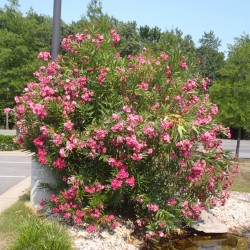
Rose Bay - Rose Laurel...
Ціна
1,95 €
SKU: T 62
Seeds Gallery Com,
5/
5
<!DOCTYPE html>
<html>
<head>
<meta http-equiv="Content-Type" content="text/html; charset=UTF-8" />
</head>
<body>
<h2><span style="font-size: 14pt;"><strong>Rose Bay - Rose Laurel Seeds (Nerium oleander)</strong></span></h2>
<h2><span style="color: #ff0000; font-size: 14pt;"><strong>Price for Package of 10 seeds.</strong></span></h2>
<p>Undoubtedly a candidate for most poisonous plant in the garden but also a contender for most beautiful.</p>
<p>This species is considered to be native to Spain, the Balearic Islands and Morocco east through Mediterranean coastal countries to the Arabian Peninsula, Ethiopia, Niger, Afghanistan, Iran and Iraq to India and central China. It occurs as a non-native in parts of Africa, the Azores, Japan, Indonesia, Australia, New Zealand, the United States, central and eastern Mexico, Central and South America.</p>
<p>This species is very widely cultivated as an ornamental. All parts of the plant are poisonous and so it is not grazed or eaten. Steam from boiled leaves is inhaled to relieve sinusitis, pounded leaves are applied to the skin to relieve itching, ulcers and tumours (Jongbloed 2003); the leaves are used as an insecticide.</p>
<p>Nerium</p>
<p>Believed to come from the Greek ‘nerion’ which is, itself, believed to be based on ‘neros’, ‘wet’ or ‘fresh’.</p>
<p>oleander</p>
<p>Possibly a combination of the Latin ‘olea’, ‘olive’ and ‘rodandrum’, ‘rhododendron’ meaning the plant looks somewhat similar to a cross between these two.</p>
<p>Common Names and Synonyms</p>
<p>oleander, rose bay, common oleander, rose laurel</p>
<h2>WIKIPEDIA:</h2>
<p>Nerium oleander /ˈnɪəriəm ˈoʊliː.ændər/[3] is an evergreen shrub or small tree in the dogbane family Apocynaceae, toxic in all its parts. It is the only species currently classified in the genus Nerium. It is most commonly known as oleander, from its superficial resemblance to the unrelated olive Olea.[Note 1] It is so widely cultivated that no precise region of origin has been identified, though southwest Asia has been suggested. The ancient city of Volubilis in Morocco may have taken its name from the Berber name oualilt for the flower.[4] Oleander is one of the most poisonous commonly grown garden plants.</p>
<p><strong>Description</strong></p>
<p>Oleander grows to 2–6 m (6.6–19.7 ft) tall, with erect stems that splay outward as they mature; first-year stems have a glaucous bloom, while mature stems have a grayish bark. The leaves are in pairs or whorls of three, thick and leathery, dark-green, narrow lanceolate, 5–21 cm (2.0–8.3 in) long and 1–3.5 cm (0.39–1.38 in) broad, and with an entire margin. The flowers grow in clusters at the end of each branch; they are white, pink to red,[Note 2] 2.5–5 cm (0.98–1.97 in) diameter, with a deeply 5-lobed fringed corolla round the central corolla tube. They are often, but not always, sweet-scented.[Note 3] The fruit is a long narrow capsule 5–23 cm (2.0–9.1 in) long, which splits open at maturity to release numerous downy seeds.</p>
<p><strong>Habitat and range</strong></p>
<p>N. oleander is either native or naturalized to a broad area from Mauritania, Morocco, and Portugal eastward through the Mediterranean region and the Sahara (where it is only found sporadically), to the Arabian peninsula, southern Asia, and as far East as Yunnan in southern parts of China.[5][6][7][8] It typically occurs around dry stream beds. Nerium oleander is planted in many subtropical and tropical areas of the world. On the East Coast of the US, it grows as far north as Virginia Beach, Virginia, while in California and Texas it is naturalized as a median strip planting.[citation needed] Because of its durability, Oleander was planted prolifically on Galveston Island in Texas after the disastrous Hurricane of 1900. They are so prolific that Galveston is known as the 'Oleander City'; an annual Oleander festival is hosted every spring.[9] Oleander can be grown successfully outdoors in southern England, particularly in London and mild coastal regions of Dorset and Cornwall.</p>
<p><strong>Ecology</strong></p>
<p>Some invertebrates are known to be unaffected by oleander toxins, and feed on the plants. Caterpillars of the polka-dot wasp moth (Syntomeida epilais) feed specifically on oleanders and survive by eating only the pulp surrounding the leaf-veins, avoiding the fibers. Larvae of the common crow butterfly (Euploea core) also feed on oleanders, and they retain or modify toxins, making them unpalatable to would-be predators such as birds, but not to other invertebrates such as spiders and wasps.</p>
<p>The flowers require insect visits to set seed, and seem to be pollinated through a deception mechanism. The showy corolla acts as a potent advertisement to attract pollinators from a distance, but the flowers are nectarless and offer no reward to their visitors. They therefore receive very few visits, as typical of many rewardless flower species.[11][12] Fears of honey contamination with toxic oleander nectar are therefore unsubstantiated.</p>
<p><strong>Ornamental gardening</strong></p>
<p>Oleander is a vigorous grower in warm subtropical regions, where it is extensively used as an ornamental plant in parks, along roadsides, and as a windbreak. It will tolerate occasional light frost down to −10 °C (14 °F).,[8] though the leaves may be damaged. The toxicity of Oleander renders it deer-resistant. The plant is tolerant of poor soils, salt spray, and sustained drought, although it will flower and grow more vigorously with regular water. Nerium Oleander also responds well to heavy pruning, which should be done in the autumn or early spring to keep plants from becoming unruly.</p>
<p>In cold-winter climates Oleander can be grown in greenhouses and conservatories, or as potted indoor plants that can be kept outside in the summer. Oleander flowers are showy, profuse, and often fragrant, which makes them very attractive in many contexts. Over 400 cultivars have been named, with several additional flower colors not found in wild plants having been selected, including red, pink, yellow, and salmon; white and a variety of pinks are the most common. Double flowered cultivars like 'Mrs Isadore Dyer' or 'Mont Blanc' are enjoyed for their large, rose-like blooms and strong fragrance. Many dwarf cultivars have also been developed, which grow only to about 10' at maturity. In most Mediterranean climates they can be expected to bloom from April through October, with their heaviest bloom usually in May or June.</p>
<p><strong>Toxicity</strong></p>
<p>Oleander has historically been considered a poisonous plant because some of its compounds may exhibit toxicity, especially to animals, when consumed in large amounts. Among these compounds are oleandrin and oleandrigenin, known as cardiac glycosides, which are known to have a narrow therapeutic index and can be toxic when ingested.</p>
<p>Toxicity studies of animals administered oleander extract concluded that rodents and birds were observed to be relatively insensitive to oleander cardiac glycosides.[16] Other mammals, however, such as dogs and humans, are relatively sensitive to the effects of cardiac glycosides and the clinical manifestations of "glycoside intoxication".</p>
<p>However, despite the common "poisonous" designation of this plant, very few toxic events in humans have been reported. According to the Toxic Exposure Surveillance System, in 2002, 847 human exposures to oleander were reported to poison centers in the United States.[19] Despite this exposure level, from 1985 through 2005, only three deaths were reported. One cited death was apparently due to the ingestion of oleander leaves by a diabetic man.[20] His blood indicated a total blood concentration of cardiac glycosides of about 20 μg/l, which is well above the reported fatal level. Another study reported on the death of a woman who self-administered "an undefined oleander extract" both orally and rectally and her oleandrin tissue levels were 10 to 39 μg/g, which were in the high range of reported levels at autopsy.[21] And finally, one study reported the death of a woman who ingested oleander 'tea'.[22] Few other details were provided.</p>
<p>In contrast to consumption of these undefined oleander-derived materials, no toxicity or deaths were reported from topical administration or contact with N. oleander or specific products derived from them. In reviewing oleander toxicity, Lanford and Boor[23] concluded that, except for children who might be at greater risk, "the human mortality associated with oleander ingestion is generally very low, even in cases of moderate intentional consumption (suicide attempts)".</p>
<p>Toxicity studies conducted in dogs and rodents administered oleander extracts by intramuscular injection indicated that, on an equivalent weight basis, doses of an oleander extract with glycosides 10 times those likely to be administered therapeutically to humans are still safe and without any "severe toxicity observed".</p>
<p>In South Indian states such as Tamil Nadu and in Sri Lanka the seeds of related plant with similar local name (Kaneru(S) කණේරු) Cascabela thevetia produce a poisonous plum with big seeds. As these seeds contain cardenolides, swallowing them is one of the preferred methods for suicides in villages.</p>
<p><strong>Effects of poisoning</strong></p>
<p>Ingestion of this plant can affect the gastrointestinal system, the heart, and the central nervous system. The gastrointestinal effects can consist of nausea and vomiting, excess salivation, abdominal pain, diarrhea that may contain blood, and especially in horses, colic.[7] Cardiac reactions consist of irregular heart rate, sometimes characterized by a racing heart at first that then slows to below normal further along in the reaction. Extremities may become pale and cold due to poor or irregular circulation. The effect on the central nervous system may show itself in symptoms such as drowsiness, tremors or shaking of the muscles, seizures, collapse, and even coma that can lead to death.</p>
<p>Oleander sap can cause skin irritations, severe eye inflammation and irritation, and allergic reactions characterized by dermatitis.</p>
<p><strong>Treatment</strong></p>
<p>Poisoning and reactions to oleander plants are evident quickly, requiring immediate medical care in suspected or known poisonings of both humans and animals.[25] Induced vomiting and gastric lavage are protective measures to reduce absorption of the toxic compounds. Charcoal may also be administered to help absorb any remaining toxins.[7] Further medical attention may be required depending on the severity of the poisoning and symptoms. Temporary cardiac pacing will be required in many cases (usually for a few days) until the toxin is excreted.</p>
<p>Digoxin immune fab is the best way to cure an oleander poisoning if inducing vomiting has no or minimal success, although it is usually used only for life-threatening conditions due to side effects.</p>
<p>Drying of plant materials does not eliminate the toxins. It is also hazardous for animals such as sheep, horses, cattle, and other grazing animals, with as little as 100 g being enough to kill an adult horse.[26] Plant clippings are especially dangerous to horses, as they are sweet. In July 2009, several horses were poisoned in this manner from the leaves of the plant.[27] Symptoms of a poisoned horse include severe diarrhea and abnormal heartbeat. There is a wide range of toxins and secondary compounds within oleander, and care should be taken around this plant due to its toxic nature. Different names for oleander are used around the world in different locations, so, when encountering a plant with this appearance, regardless of the name used for it, one should exercise great care and caution to avoid ingestion of any part of the plant, including its sap and dried leaves or twigs. The dried or fresh branches should not be used for spearing food, for preparing a cooking fire, or as a food skewer. Many of the oleander relatives, such as the desert rose (Adenium obesum) found in East Africa, have similar leaves and flowers and are equally toxic.</p>
<p><strong>Folklore</strong></p>
<p>The alleged toxicity of the plant makes it the center of an urban legend documented on several continents and over more than a century. Often told as a true and local event, typically an entire family, or in other tellings a group of scouts, succumbs after consuming hot dogs or other food roasted over a campfire using oleander sticks.</p>
<p><strong>Garden history</strong></p>
<p>In his book Enquiries into Plants of circa 300 BC, Theophrastus described (among plants that affect the mind) a shrub he called onotheras, which modern editors render oleander; "the root of onotheras [oleander] administered in wine", he alleges, "makes the temper gentler and more cheerful".</p>
<p>The plant has a leaf like that of the almond, but smaller, and the flower is red like a rose. The plant itself (which loves hilly country) forms a large bush; the root is red and large, and, if this is dried, it gives off a fragrance like wine.</p>
<p>In another mention, of "wild bay" (Daphne agria), Theophrastus appears to intend the same shrub.</p>
<p>Oleander was a very popular ornamental shrub in Roman peristyle gardens; it is one of the flora most frequently depicted on murals in Pompeii and elsewhere in Italy. These murals include the famous garden scene from the House of Livia at Prima Porta outside Rome, and those from the House of the Wedding of Alexander and the Marine Venus in Pompeii.</p>
<p>Willa Cather, in her book The Song of the Lark, mentions oleander in this passage:</p>
<p>This morning Thea saw to her delight that the two oleander trees, one white and one red, had been brought up from their winter quarters in the cellar. There is hardly a German family in the most arid parts of Utah, New Mexico, Arizona, but has its oleander trees. However loutish the American-born sons of the family may be, there was never one who refused to give his muscle to the back-breaking task of getting those tubbed trees down into the cellar in the fall and up into the sunlight in the spring. They may strive to avert the day, but they grapple with the tub at last.</p>
<p>Oleander is the official flower of the city of Hiroshima, having been the first to bloom following the atomic bombing of the city in 1945.</p>
<p>It is the provincial flower of Sindh province.</p>
</body>
</html>
T 62 P

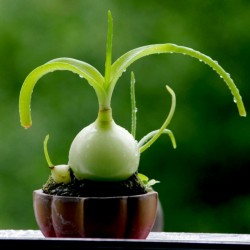
Насіння цибулі морської...
Ціна
3,80 €
SKU: CT 23
Seeds Gallery Com,
5/
5
<!DOCTYPE html>
<html>
<head>
<meta http-equiv="Content-Type" content="text/html; charset=UTF-8" />
</head>
<body>
<h2><strong>Насіння цибулі морської (Albuca bracteata) </strong></h2>
<h2><strong><span style="color: #ff0000;">Ціна за упаковку з 3 насінин.</span> </strong></h2>
<p>Albuca bracteata (син. Ornithogalum longebracteatum), відомий під загальними назвами вагітна цибуля, помилкова морська цибуля та морська цибуля. Це вид цибулинних квітучих рослин із сімейства спаржевих. Його квіткові стебла можуть досягати висоти 90 см і можуть нести до 100 зеленувато-білих квіток.</p>
<p>Ланцетні листя у формі ремінця, довжиною 60 см (2 фути) і шириною 2,5 см (1 дюйм), виступають із об’ємної цибулини, яка значною мірою знаходиться над землею. Коріння білі та соковиті. Багато дрібних, запашних, білих квіток діаметром 0,5 см і зеленою серединкою є на кистях, які можуть досягати 70–90 см заввишки. Цвітіння зазвичай відбувається з весни до початку зими (з травня по серпень у північній півкулі), на одному стеблі від 50 до 100 квіток. Одна рослина може мати до 300 квіток одночасно. Фруктові капсули мають довжину 10 мм і діаметр 6 мм. Насіння довгасті з розмірами 4 на 1,5 мм. Albuca bracteata є криптофітом, оскільки листя відмирає в періоди посухи.</p>
<p>Часто вирощується як декоративна рослина. Рослина дуже пристосовується і тому ідеально підходить для вирощування в контейнерах. Віддає перевагу пряме сонце. Субстрат повинен бути добре дренованим.</p>
<p>Витримує температуру до -5 ° C.</p>
<p>У медицині подрібнене листя рослини використовують для лікування порізів і синців. За деякими джерелами, лікарська дія цієї рослини подібна до дії алое вера.</p>
</body>
</html>
CT 23 (3 S)


Ця рослина має гігантські плоди
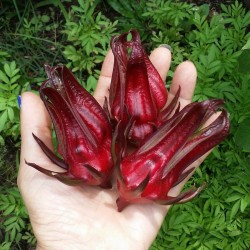
Гігантські Roselle насіння...
Ціна
3,50 €
SKU: MHS 19 G
Seeds Gallery Com,
5/
5
<div>
<h2 class=""><strong>Гігантські Roselle насіння (Hibiscus sabdariffa)</strong></h2>
<h2><span style="color: #ff0000;" class=""><strong>Ціна за упаковку з 5 насінин.</strong></span></h2>
<p><strong><span style="color: #000000; font-size: 18px;">Плоди цієї розелі вдвічі більші за будь-яку іншу розель.</span></strong><br>The roselle (Hibiscus sabdariffa) is a species of Hibiscus native to the Old World tropics, used for the production of bast fibre and as an infusion. It is an annual or perennial herb or woody-based subshrub, growing to 2–2.5 m (7–8 ft) tall. The leaves are deeply three- to five-lobed, 8–15 cm (3–6 in) long, arranged alternately on the stems.</p>
</div>
<p>The flowers are 8–10 cm (3–4 in) in diameter, white to pale yellow with a dark red spot at the base of each petal, and have a stout fleshy calyx at the base, 1–2 cm (0.39–0.79 in) wide, enlarging to 3–3.5 cm (1.2–1.4 in), fleshy and bright red as the fruit matures. It takes about six months to mature.</p>
<p><span><strong>Names</strong></span></p>
<p><span>The roselle is known as the rosella or rosella fruit in Australia. It is also known as 'Belchanda' among Nepalese, Tengamora among Assamese and "mwitha" among Bodo tribals in Assam, চুকর Chukor in Bengali, Gongura in Telugu, Pundi in Kannada, Ambadi in Marathi, LalChatni or Kutrum in Mithila] Mathipuli in Kerala, chin baung in Burma, กระเจี๊ยบแดง KraJiabDaeng in Thailand, ສົ້ມ ພໍດີ som phor dee in Lao PDR, bissap in Senegal, Guinea Bissau, Mali, Burkina Faso, Ghana, Benin and Niger, the Congo and France, dah or dah bleni in other parts of Mali, wonjo in the Gambia, zobo in western Nigeria (the Yorubas in Nigeria call the white variety Isapa (pronounced Ishapa)), Zoborodo in Northern Nigeria, Chaye-Torosh in Iran, karkade (كركديه; Arabic pronunciation: [ˈkarkade])[dubious – discuss] in Egypt, Saudi Arabia, and Sudan, omutete in Namibia, sorrel in the Caribbean and in Latin America, Flor de Jamaica in Mexico, Saril in Panama, grosella in Paraguay and vinagreira, caruru-azedo or quiabo-roxo in Brazil. Rosela in Indonesia, asam belanda[1] in Malaysia. In Chinese it is 洛神花 (Luo Shen Hua) . In Zambia the plant is called lumanda in ciBemba, katolo in kiKaonde, or wusi in chiLunda.</span></p>
<p><span><strong>Uses</strong></span></p>
<p><span>The plant is considered to have antihypertensive properties. In some places, the plant is primarily cultivated for the production of bast fibre from the stem of the plant. The fibre may be used as a substitute for jute in making burlap.[2] Hibiscus, specifically Roselle, has been used in folk medicine as a diuretic, mild laxative, and treatment for cardiac and nerve diseases and cancer.[3]</span></p>
<p><span>The red calyces of the plant are increasingly exported to America and Europe, where they are used as food colourings. Germany is the main importer. It can also be found in markets (as flowers or syrup) in some places such as France, where there are Senegalese immigrant communities. The green leaves are used like a spicy version of spinach. They give flavour to the Senegalese fish and rice dish thiéboudieune. Proper records are not kept, but the Senegalese government estimates national production and consumption at 700 t (770 short tons) per year. Also in Burma their green leaves are the main ingredient in making chin baung kyaw curry.</span></p>
<p><span>In East Africa, the calyx infusion, called "Sudan tea", is taken to relieve coughs. Roselle juice, with salt, pepper, asafoetida and molasses, is taken as a remedy for biliousness.</span></p>
<p><span>The heated leaves are applied to cracks in the feet and on boils and ulcers to speed maturation. A lotion made from leaves is used on sores and wounds. The seeds are said to be diuretic and tonic in action and the brownish-yellow seed oil is claimed to heal sores on camels. In India, a decoction of the seeds is given to relieve dysuria, strangury and mild cases of dyspepsia. Brazilians attribute stomachic, emollient and resolutive properties to the bitter roots.[4]</span></p>
<p><span><strong>Leafy vegetable/Greens</strong></span></p>
<p><span>In Andhra cuisine, Hibiscus cannabinus, called Gongura, is extensively used. The leaves are steamed along with lentils and cooked with Dal. The other unique dish prepared is gongura pachadi, it is prepared by mixing fried leaves with spices and made into a Gongura Pacchadi, the most famous dish of Andhra cuisine and is often described as king of all foods of Andhra ethnics(andhrulu)</span></p>
<p><span>In Burmese cuisine, called chin baung ywet (lit. sour leaf), the roselle is widely used and considered an affordable vegetable for the population. It is perhaps the most widely eaten and popular vegetable in Burma.[5] The leaves are fried with garlic, dried or fresh prawns and green chili or cooked with fish. A light soup made from roselle leaves and dried prawn stock is also a popular dish.</span></p>
<p><span><strong>Beverage</strong></span></p>
<p><span>Cuisine: Among the Bodo tribals of Bodoland, Assam (India) the leaves of both hibiscus sabdariffa and hibiscus cannabinus are cooked along with chicken, fish or pork, one of their traditional cuisines</span></p>
<p><span>In the Caribbean sorrel drink is made from sepals of the roselle. In Malaysia, roselle calyces are harvested fresh to produce pro-health drink due to high contents of vitamin C and anthocyanins. In Mexico, 'agua de Flor de Jamaica' (water flavored with roselle) frequently called "agua de Jamaica" is most often homemade. Also, since many untrained consumers mistake the calyces of the plant to be dried flowers, it is widely, but erroneously, believed that the drink is made from the flowers of the non-existent "Jamaica plant". It is prepared by boiling dried sepals and calyces of the Sorrel/Flower of Jamaica plant in water for 8 to 10 minutes (or until the water turns red), then adding sugar. It is often served chilled. This is also done in Saint Kitts and Nevis, Guyana, Antigua, Barbados, St. Lucia, Dominica, Grenada, Jamaica and Trinidad and Tobago where it is called 'sorrel'. The drink is one of several inexpensive beverages (aguas frescas) commonly consumed in Mexico and Central America, and they are typically made from fresh fruits, juices or extracts. A similar thing is done in Jamaica but additional flavor is added by brewing the tea with ginger and adding rum. It is a popular drink of the country at Christmas time. It is also very popular in Trinidad & Tobago but cinnamon, cloves and bay leaves are preferred to ginger. In Mali, Senegal, The Gambia, Burkina Faso and Benin calyces are used to prepare cold, sweet drinks popular in social events, often mixed with mint leaves, dissolved menthol candy, and/or various fruit flavors. The Middle Eastern and Sudanese drink "Karkade"(كركديه) is a cold drink made by soaking the dried Karkade flowers in cold water over night in a refrigerator with sugar and some lemon or lime juice added.It is then consumed with or without ice cubes after the flowers have been strained.In Lebanon, sometimes toasted pine nuts are tossed into the drink.</span></p>
<p><span>With the advent in the U.S. of interest in south-of-the-border cuisine, the calyces are sold in bags usually labeled "Flor de Jamaica" and have long been available in health food stores in the U.S. for making a tea that is high in vitamin C. This drink is particularly good for people who have a tendency, temporary or otherwise, toward water retention: it is a mild diuretic.</span></p>
<p><span>In addition to being a popular homemade drink, Jarritos, a popular brand of Mexican soft drinks, makes a Flor de Jamaica flavored carbonated beverage. Imported Jarritos can be readily found in the U.S.</span></p>
<p><span>In the UK the dried calyces and ready-made sorrel syrup are widely and cheaply available in Caribbean and Asian grocers. The fresh calyces are imported mainly during December and January in order to make Christmas and New Year infusions, which are often made into cocktails with additional rum. They are very perishable, rapidly developing fungal rot, and need to be used soon after purchase – unlike the dried product, which has a long shelf-life.</span></p>
<p><span>In Africa, especially the Sahel, roselle is commonly used to make a sugary herbal tea that is commonly sold on the street. The dried flowers can be found in every market. Roselle tea is also quite common in Italy where it spread during the first decades of the 20th century as a typical product of the Italian colonies. The Carib Brewery Trinidad Limited, a Trinidad and Tobago brewery, produces a Shandy Sorrel in which the tea is combined with beer.</span></p>
<p><span>In Thailand, Roselle is generally drunk as a cool drink,[6] but also as a tea, believed to also reduce cholesterol. It can also be made into a wine.</span></p>
<p><span>Hibiscus flowers are commonly found in commercial herbal teas, especially teas advertised as berry-flavoured, as they give a bright red colouring to the drink.</span></p>
<p><span>Rosella flowers are sold as Wild Hibiscus flowers in syrup in Australia as a gourmet product. Recipes include filling them with goats cheese, serving them on baguette slices baked with brie, & placing one plus a little syrup, in a champagne flute before adding the champagne when the bubbles cause the flower to open.</span></p>
<p><span><strong>Jam and preserves</strong></span></p>
<p><span>In Nigeria, rosella jam has been made since Colonial times and is still sold regularly at community fetes and charity stalls. It is similar in flavour to plum jam, although more acidic. It differs from other jams in that the pectin is obtained from boiling the interior buds of the rosella flowers. It is thus possible to make rosella jam with nothing but rosella buds and sugar. Roselle is also used in Nigeria to make a refreshing drink known as Zobo.</span></p>
<p><span>In Burma, the buds of the roselle are made into 'preserved fruits' or jams. Depending on the method and the preference, the seeds are either removed or included. The jams, made from roselle buds and sugar, are red and tangy.</span></p>
<p><span>"Sorrel jelly" is manufactured in Trinidad.</span></p>
<p><span>Rosella Jam is also made in Queensland, Australia as a home-made or speciality product sold at fetes and other community events.[7]</span></p>
<p><span><strong>Medicinal uses</strong></span></p>
<p><span>Many parts of the plant are also claimed to have various medicinal values. They have been used for such purposes ranging from Mexico through Africa and India to Thailand. Roselle is associated with traditional medicine and is reported to be used as treatment for several diseases such as hypertension and urinary tract infections.[8]</span></p>
<p><span>Although Roselle has well documented hypotensive effects,[9] there is currently insufficient evidence to support the benefit of Roselle for either controlling or lowering blood pressure due to a lack of well designed studies that measure the efficacy of Roselle on patients with hypertension.[10]</span></p>
<p><span>A double blind, placebo controlled, randomized trial was conducted to determine the effect of Roselle leaf extract on a group of 60 subjects with serum LDL values in the range of 130-190 ml/dl (<130 ml/dl is a goal value for most patients[11]) and no history of coronary heart disease. The experimental group received 1g of Roselle leaf extract while the placebo group received a similar amount of maltodextrin in addition to dietary and physical activity advice. Both groups had decreases in body weight, LDL cholesterol, and triglycerides that can likely be attributed to the dietary and physical activity advice. At a dose of 1g/day, Roselle leaf extract did not appear to have a blood lipid lowering effect.[12]</span></p>
<p><span>Hibiscus sabdariffa has shown in vitro antimicrobial activity against E. coli.[13] A recent review stated that specific extracts of H. sabdariffa exhibit activities against atherosclerosis, liver disease, cancer, diabetes and other metabolic syndromes.</span></p>
<p><span><strong>Phytochemicals</strong></span></p>
<p><span>The plants are rich in anthocyanins, as well as protocatechuic acid. The dried calyces contain the flavonoids gossypetin, hibiscetine and sabdaretine. The major pigment, formerly reported as hibiscin, has been identified as daphniphylline. Small amounts of myrtillin (delphinidin 3-monoglucoside), Chrysanthenin (cyanidin 3-monoglucoside), and delphinidin are also present. Roselle seeds are a good source of lipid-soluble antioxidants, particularly gamma-tocopherol.[15]</span></p>
<p> </p>
<p><span><strong>Production</strong></span></p>
<p><span>China and Thailand are the largest producers and control much of the world supply. Thailand invested heavily in roselle production and their product is of superior quality, whereas China's product, with less stringent quality control practices, is less reliable and reputable. The world's best roselle comes from the Sudan, but the quantity is low and poor processing hampers quality. Mexico, Egypt, Senegal, Tanzania, Mali and Jamaica are also important suppliers but production is mostly used domestically.[16]</span></p>
<p><span>In the Indian subcontinent (especially in the Ganges Delta region), roselle is cultivated for vegetable fibres. Roselle is called meśta (or meshta, the ś indicating an sh sound) in the region. Most of its fibres are locally consumed. However, the fibre (as well as cuttings or butts) from the roselle plant has great demand in various natural fibre using industries.</span></p>
<p><span>Roselle is a relatively new crop to create an industry in Malaysia. It was introduced in early 1990s and its commercial planting was first promoted in 1993 by the Department of Agriculture in Terengganu. The planted acreage was 12.8 ha (30 acres) in 1993, but had steadily increased to peak at 506 ha (1,000 acres) in 2000. The planted area is now less than 150 ha (400 acres) annually, planted with two main varieties.[citation needed] Terengganu state used to be the first and the largest producer, but now the production has spread more to other states. Despite the dwindling hectarage over the past decade or so, roselle is becoming increasingly known to the general population as an important pro-health drink in the country. To a small extent, the calyces are also processed into sweet pickle, jelly and jam. jimmon rubillos</span></p>
<p><span><strong>Crop research</strong></span></p>
<p><span>In the initial years, limited research work were conducted by University Malaya (UM) and Malaysian Agricultural Research and Development Institute (MARDI). Research work at Universiti Kebangsaan Malaysia (UKM) was initiated in 1999. In many respect, the amount of research work is still considered meagre in supporting a growing roselle industry in Malaysia.</span></p>
<p><span>Crop genetic resources & improvement[edit]</span></p>
<p><span>Genetic variation is important for plant breeders to increase the crop productivity. Being an introduced species in Malaysia, there is a very limited number of germplasm accessions available for breeding. At present, UKM maintains a working germplasm collection, and also conducts agronomic research and crop improvement.</span></p>
<p><span>Mutation breeding[edit]</span></p>
<p><span>Genetic variation is important for plant breeders to increase its productivity. Being an introduced crop species in Malaysia, there is a limited number of germplasm accessions available for breeding. Furthermore, conventional hybridization is difficult to carry out in roselle due to its cleistogamous nature of reproduction. Because of this, a mutation breeding programme was initiated to generate new genetic variability.[17] The use of induced mutations for its improvement was initiated in 1999 in cooperation with MINT (now called Malaysian Nuclear Agency), and has produced some promising breeding lines. Roselle is a tetraploid species; thus, segregating populations require longer time to achieve fixation as compared to diploid species. In April 2009, UKM launched three new varieties named UKMR-1, UKMR-2 and UKMR-3, respectively. These three new varieties were developed using variety Arab as the parent variety in a mutation breeding programme which started in 2006.</span></p>
<p><span><strong>Natural outcrossing under local conditions</strong></span></p>
<p><span>A study was conducted to estimate the amount of outcrossing under local conditions in Malaysia. It was found that outcrossing occurred at a very low rate of about 0.02%. However, this rate is much lower in comparison to estimates of natural cross-pollination of between 0.20% and 0.68% as reported in Jamaica.</span></p>
<p><span><strong>Source: Wikipedia</strong></span></p>
MHS 19 G (5 S)

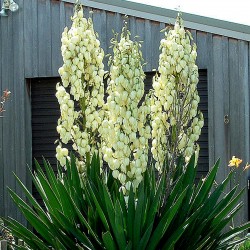
Насіння Юка нитчата (Yucca...
Ціна
2,35 €
SKU: CT 8
Seeds Gallery Com,
5/
5
<h2 class=""><strong>Насіння Юка нитчата (Yucca filamentosa)</strong></h2>
<h2><span style="color: #ff0000;"><strong>Ціна за упаковку з 5 насінин.</strong></span></h2>
<p style="color: #202122; font-size: 14px;"><b>Юка нитчата</b><span> </span>(<i>Yucca filamentosa</i>) — багаторічна вічнозелена майже безстеблова з дерев'янистим стеблом рослина, вид роду<span> </span>юка<span> </span>родини<span> </span><span>холодкові</span><span> </span>(<i><span>Asparagaceae</span></i>).</p>
<p style="color: #202122; font-size: 14px;">Багаторічний вічнозелений кущ.</p>
<p style="color: #202122; font-size: 14px;">Листя лінійно-ланцетні, плоскі. Прикореневі, що ростуть з розетки — синьо-зеленого кольору, довжиною від 30 до 90 см і шириною 2-4 см, з різко загостреною м'якою або твердою верхівкою. По краях листя звисають нитки, які з часом можуть опадати.</p>
<p style="color: #202122; font-size: 14px;">Суцвіття —<span> </span>волоть<span> </span>висотою від 1 до 3(4) м. Квітки вершково-білі, жовтувато-білі або білі із зеленуватим відтінком, пониклі, від 5 до 8 см завдовжки, пелюсток 6.</p>
<p style="color: #202122; font-size: 14px;">Плід — суха округла коробочка розміром 4-5 × 2 см. Насіння чорного кольору, тонке, 6 мм в діаметрі.</p>
<h2 style="color: #000000; font-size: 1.5em;"><span id=".D0.9F.D0.BE.D1.88.D0.B8.D1.80.D0.B5.D0.BD.D0.BD.D1.8F_.D1.82.D0.B0_.D0.B5.D0.BA.D0.BE.D0.BB.D0.BE.D0.B3.D1.96.D1.8F"></span><span class="mw-headline" id="Поширення_та_екологія">Поширення та екологія</span></h2>
<p style="color: #202122; font-size: 14px;">Ареал виду охоплює схід і південний схід<span> </span>США<span> </span>від штату<span> </span>Меріленд<span> </span>і<span> </span>Нью-Гемпшир<span> </span>на півночі, штату<span> </span>Флорида<span> </span>на півдні і до штатів<span> </span>Теннессі,<span> </span>Міссісіпі<span> </span>(Небраска, Техас<sup id="cite_ref-1" class="reference">[1]</sup>) на заході.</p>
<p style="color: #202122; font-size: 14px;">Виростає на сухих, піщаних ґрунтах уздовж узбережжя або кам'янистих місцях проживання, на полях, вздовж узбіч доріг і в інших відкритих місцях.</p>
<p style="color: #202122; font-size: 14px;">Квіти з'являються в кінці весни, на початку літа.</p>
<p style="color: #202122; font-size: 14px;">У природі квіти запилюються юкковою міллю (<i>Tegeticula yucasella</i>) і схожими видами з роду<span> </span><i>Tegeticula</i><span> </span>і<span> </span><i>Parategeticula</i><span> </span>з родини<span> </span><i>Prodoxidae</i>). Самки юккових молей скачують пилок в кульку, яку переносять вночі в іншу квітку. Проникнувши в іншу квітку, самка спочатку відкладає яйця в зав'язь, після чого цілеспрямовано поміщає грудку пилку на сенсорну поверхню рильця маточки. Личинки молей харчуються розвиваються насінням, оскільки личинки дозрівають перш ніж з'їдять всі насіння, то від 60 до 80 % насіння зберігає схожість. Якщо в плоді розвивається надто багато личинок молі, рослина скидає плоди. В Європі рослина не плодоносить через відсутність юковой молі, отримання плодів можливо при штучному запиленні.</p>
<p style="color: #202122; font-size: 14px;">Розмноження: насінням, кореневими паростками, стебловими і кореневими живцями. Посів насіння проводять рядками або в розкид, в легку піщану землю із закладенням піском або легкої землею на глибину 1-2 см.</p>
<h2 style="color: #000000; font-size: 1.5em;"><span id=".D0.97.D0.B0.D1.81.D1.82.D0.BE.D1.81.D1.83.D0.B2.D0.B0.D0.BD.D0.BD.D1.8F_.D1.96_.D0.B7.D0.BD.D0.B0.D1.87.D0.B5.D0.BD.D0.BD.D1.8F"></span><span class="mw-headline" id="Застосування_і_значення">Застосування і значення</span></h2>
<p style="color: #202122; font-size: 14px;">У США волокна юки нитчатої донині додають до бавовни при виробництві джинсів — це підвищує стійкість джинсів до зносу. Також волокна юки нитчатої використовують при виробництві канатних мотузок і паперу.</p>
<p style="color: #202122; font-size: 14px;">Як декоративна рослина вирощується у всіх частинах світу. Також використовується для створення композицій у ландшафтному дизайні.</p>
<h3 style="color: #000000; font-size: 1.2em;"><span id=".D0.A3_.D0.BD.D0.B0.D1.80.D0.BE.D0.B4.D0.BD.D1.96.D0.B9_.D0.BC.D0.B5.D0.B4.D0.B8.D1.86.D0.B8.D0.BD.D1.96"></span><span class="mw-headline" id="У_народній_медицині">У народній медицині</span></h3>
<p style="color: #202122; font-size: 14px;">Індіанські племена використовували юкку нитчату в медицині, робили мотузки, з коренів робили мило. Мазь з подрібнених коренів використовувалася для лікування розтягувань і ран на шкірі.</p>
CT 8 (5 S)





